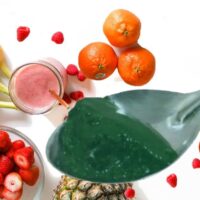Last updated on June 8th, 2023
Spirulina has so many benefits to the human body, it is sometimes difficult to believe, let alone cover in a single article. While there is plenty of living evidence to the health benefits of spirulina, there is nothing like good scientific research to illustrate the grandeur of things. In my previous post, I talked about 12 powerful nutrients that you can get from taking a tablespoon of spirulina every day. In this article, I’d like to discuss the benefits you can expect when doing that over time. So without further due, here are 10 scientifically proven benefits that you could gain from consuming spirulina on a regular basis.
Spirulina has anti-inflammatory properties
Inflammation is a condition in which part of the body becomes reddened, swollen, hot, and often painful, especially as a reaction to injury or infection.
Spirulina is an excellent source of various antioxidants such as phycocyanin, beta-carotene, and vitamin E, which protect our body against inflammation. These antioxidant proteins break down free radicals and inhibit various inflammatory mechanisms.
The anti-inflammatory and antioxidant properties of spirulina have been studied extensively on animals and concluded that spirulina is an efficient remedy for many inflammatory conditions, including arthritis, an inflammatory condition that affects the joints. Studies also suggest Spirulina’s important role in preventing the formation of tumors.
Spirulina has also been shown to reduce stroke-related brain damage, essentially allowing for more blood to reach the brain cells during and after strokes, reducing cell death.
Spirulina Lowers LDL Cholesterol and Triglyceride levels
Triglycerides are the most common type of fat in the human body. High triglyceride levels, combined with high LDL (bad cholesterol) or low HDL (good cholesterol) is linked with fatty buildups within the artery walls, which increases the risk of heart attacks and strokes.
On a personal note, one of our team members here at spirulina network has seen an incredible result. After taking spirulina for only 45 days, he has managed to lower his Triglycerides levels by half! Read the full story here.
Spirulina balances total cholesterol by reducing the level of “bad cholesterol” and triglyceride levels. At the same time, it increases the levels of HDL, known as “good cholesterol”, which has been shown to protect the heart.
In one study, people with high cholesterol intake took one gram of spirulina each day and reduced their overall blood triglyceride levels by 16.3%, and LDL cholesterol by 10.1% on average. Other studies, conducted with higher doses of 4.5 to 8 grams of spirulina per day, have also shown excellent results.
Spirulina Protects LDL Cholesterol from Oxidative Stress. A number of studies have shown that Antioxidants in Spirulina are especially effective at reducing blood lipid oxidation. In a study on 37 patients with type 2 diabetes, taking 8 grams of spirulina a day significantly reduced the signs of lipid oxidation, and increased antioxidant enzymes in the blood.
Spirulina Balances Blood Pressure
A study on people with normal blood pressure has shown a reduction in blood pressure when consuming 4.5 grams of spirulina per day. The decrease appears to be due to the increased production of nitric oxide (NO), a molecule that helps to relax and dilate blood vessels.
Spirulina Balances Blood Sugar Levels
Studies show that spirulina can significantly lower blood sugar levels even more than common drugs, including Metformin. A study conducted on type 2 diabetic patients found that taking 2 grams of spirulina a day reduced their blood sugar levels. HbA1c levels, indicating the long-term damage caused by high blood sugar, had decreased from 9% to 8%. Researchers estimate that a 1% reduction in this indicator reduces the risk of death from complications of diabetes by 21%.
Follow the link to learn more about the benefits of spirulina for diabetes patients.
Spirulina reduces allergic reactions
Suffering from allergies? This one is for you! Spirulina reduces allergic symptoms such as runny nose, itchy eyes, and sore throat. In a study of 127 people with allergic rhinitis, taking 2 g of spirulina a day significantly reduced nasal discharge, decreased sneezing, and improved nasal congestion and itching.
Spirulina is effective for the treatment of anemia
Anemia is relatively common among the elderly, causing a feeling of weakness and chronic fatigue. A study with 40 adults with a history of anemia found that taking spirulina supplementation resulted in increased levels of hemoglobin and red blood cells. The immune function has also improved.
Follow the link to learn more about the benefits of spirulina for Anemia patients.
Spirulina Improves muscle strength and endurance
Oxidative damage due to physical activity is a significant factor in muscle fatigue.
A study conducted on athletes found that spirulina significantly increased the athlete’s endurance and the time it took the muscles to tire.
Another study conducted on athletes has shown that intake of spirulina supplementation increased muscle strength, but did not increase the endurance.
Spirulina may have anti-cancer properties
Various studies suggest that spirulina may have anti-cancer properties.
Several animal studies have shown that spirulina can reduce cancer incidence and tumor size.
Spirulina has also been extensively studied in the context of treating cancer in the oral cavity. One study examined 87 people with precancerous lesions in the oral cavity. After one year of taking one gram of Spirulina a day, 45% of the Spirulina group experienced complete regression, compared to only 7% in the control group!
In one study of 40 patients with precancerous lesions, one gram of spirulina a day showed greater improvement in symptoms than Pentoxifylline, a commonly used drug for the treatment of this condition.
Spirulina Cleanses the Body From Toxic Residue
Spirulina is known to be alkalizing to the body, which boosts liver function and cleanses it. Spirulina contains chlorophyll which is used for detoxification by helping to remove toxins such as heavy metals and other pollutants from the blood.
Spirulina Improves memory and concentration
Spirulina protects the brain from free-radical damage by increasing the activity of two enzymes: catalase and glutathione peroxidase, which fight free radicals and make the brain more resistant to aging.
Spirulina’s benefits also include prevention and slow down of Alzheimer’s disease by reducing the levels of amyloid-beta proteins in the brain. People with Alzheimer’s disease have abnormally high concentrations of this protein, which accumulates into plaques and leads to severe memory loss, in addition to other problems. Animal subjects that eat spirulina are known to score higher on tests of memory and brain function.
Spirulina also aids various mental and emotional disorders, including anxiety, stress, depression and attention deficit-hyperactivity disorder (ADHD).
Summary
We live in a world that presents many challenges for humans and animals alike – from air pollution, through high levels of stress and food that grows on malnourished lands. Spirulina has everything that is needed to help us maintain a balanced diet, free from the diseases of the age of plenty.
Sources of information
- https://www.ncbi.nlm.nih.gov/pubmed/12061427
- http://www.sciencedirect.com/science/article/pii/S0891584910005381
- https://www.ncbi.nlm.nih.gov/pmc/articles/PMC3136577/
- http://ntrs.nasa.gov/archive/nasa/casi.ntrs.nasa.gov/19890016190.pdf
- https://ndb.nal.usda.gov/ndb/search
- https://www.ncbi.nlm.nih.gov/pubmed/10552882
- https://www.ncbi.nlm.nih.gov/pubmed/19702862
- http://www.sciencedirect.com/science/article/pii/S0891584910005381
- https://www.ncbi.nlm.nih.gov/pubmed/19299804
- https://www.ncbi.nlm.nih.gov/pubmed/24691130
- https://www.ncbi.nlm.nih.gov/pubmed/12769719
- https://www.ncbi.nlm.nih.gov/pubmed/12639401
- https://www.ncbi.nlm.nih.gov/pubmed/23754631
- https://www.ncbi.nlm.nih.gov/pmc/articles/PMC2211748/
- https://www.ncbi.nlm.nih.gov/pubmed/18714150
- https://www.ncbi.nlm.nih.gov/pubmed/10459507
- https://www.ncbi.nlm.nih.gov/pubmed/25547488
- http://journals.lww.com/co-lipidology/Abstract/2009/10000/Circulating_oxidized_LDL__a_biomarker_and_a.3.aspx
- https://www.ncbi.nlm.nih.gov/pmc/articles/PMC4320919/
- https://www.ncbi.nlm.nih.gov/pmc/articles/PMC3576896/
- https://www.ncbi.nlm.nih.gov/pmc/articles/PMC2788188/
- https://www.ncbi.nlm.nih.gov/pmc/articles/PMC2695150/
- https://www.ncbi.nlm.nih.gov/pubmed/19432881
- https://www.ncbi.nlm.nih.gov/pubmed/8584455
- https://www.ncbi.nlm.nih.gov/pmc/articles/PMC3919363/
- https://www.ncbi.nlm.nih.gov/pubmed/19298191
- https://www.ncbi.nlm.nih.gov/pubmed/24324897
- https://www.ncbi.nlm.nih.gov/pubmed/18343939
- https://www.ncbi.nlm.nih.gov/pubmed/18809092/
- https://www.ncbi.nlm.nih.gov/pmc/articles/PMC4012879/
- https://www.ncbi.nlm.nih.gov/pubmed/20010119
- https://www.ncbi.nlm.nih.gov/pubmed/16944194
- http://journalss.sfu.ca/ijmbs/index.php/ijmbs/article/viewArticle/51
- https://www.ncbi.nlm.nih.gov/pubmed/23121873
- https://www.ncbi.nlm.nih.gov/pubmed/23368938
- https://www.ncbi.nlm.nih.gov/pubmed/22561632
- http://www.bmj.com/content/321/7258/405
- https://www.ncbi.nlm.nih.gov/pubmed/16615668
- http://www.jebas.org/00300120022015/Mona%20JEBAS.pdf
- https://www.hindawi.com/journals/mi/2002/687526/abs/





